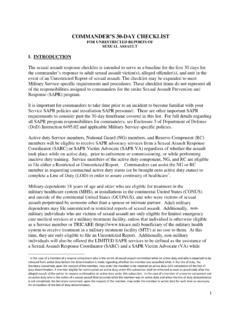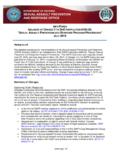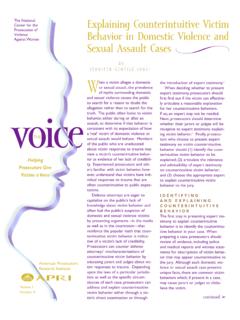Transcription of Forensic Evidence Collection for Nurses - - RN.org®
1 Evidence Collection for Nurses . Reviewed May, 2017, Expires May, 2019. Provider Information and Specifics available on our Website Unauthorized Distribution Prohibited 2017 , , , LLC. By Melissa Slate, RN, BA, MA. Objectives By the end of this educational encounter, the nurse will be able to: 1. Identify basic steps in Evidence Collection . 2. Recognize the importance of chain of custody. 3. Recognize the need for all Nurses to be familiar with Evidence Collection . The purpose of this course is to acquaint the nurse with Evidence Collection for Nurses and give the nurse a working knowledge of the steps involved to preserve the chain of custody and safeguard the validity and admissibility of Evidence for legal purposes. The information contained within this continuing education activity it is not meant to serve as a comprehensive resource on Evidence Collection .
2 Forensic Nursing - The application of nursing science to public or legal proceedings. Forensics - pertaining to the law Forensic Science Forensic science is not just one discipline, but is composed of scientific knowledge from a wide variety of scientific areas. The knowledge from these many fields of science come together with the disciplines of law and justice to create forensics. Forensics deals with the recognition, identification, and evaluation of Evidence collected in criminal investigations. There are three main areas of forensics: Biology: the investigation of crimes against people. Involves the Collection of body fluids, hairs, and fibers among other types of Evidence from living sources. Drugs and Toxicology: involves criminal and non-criminal deaths as well as crimes associated with the use of drugs such as drunken driving, overdose, or crimes committed while intoxicated.
3 Chemistry: involves the identification and analysis of paint chips, drugs, glass, or other chemical compounds to determine their composition and origin. Forensic Nursing Forensic nursing skills are needed by Nurses in every healthcare setting; the need for forensics in nursing is not limited to just Nurses who choose to specialize in this field of medicine. Every patient may be a Forensic nursing case before you are able to assess them and determine their medical problems and nursing care needs. In the ER, you may encounter rape victims, child abuse and elder abuse as well as domestic violence cases. There may be hit and run accidents or gunshot wounds. Victims of hit and run accidents and gunshot wounds are likely to make it into an OR where you might be working, or sent home with complex dressings that you will need to teach and monitor as a home health nurse .
4 In all these scenarios, your Evidence Collection (and think about it, your assessment alone can be Evidence ) can make or break a case for a patient who has been the victim of a crime; or worse yet committed the crime. The Forensic skills that are required by all Nurses are basic principles of Evidence Collection , chain of custody, and documentation of Forensic findings (Stowkowski, 2008). Collecting and preserving Evidence is a Nurses legal, ethical, and professional responsibility. Some facilities have the luxury of having a specialized forensics nurse on staff, but this is not the norm; usually this responsibility falls to the nurse caring for the patient. When staff lack proper education, these duties may be perceived by the nurse as a burden, and vital Evidence that could make or break a case for a patient may be lost as a result.
5 There are two standards of care established by the Joint Commission that require Nurses to identify abuse and neglect and assess patients within the context of the requirements. This standard makes it mandatory for all Nurses to preserve Evidence and support future legal actions in the cases of physical assault, rape, sexual molestation, domestic abuse, child abuse, or neglect, and elder abuse or neglect. All Nurses must know how and when to make appropriate referrals for the care of such victims. Nurses are often the first health care professional to see patients who are victims of crime or accidents. The procedures involved in collecting of Forensic Evidence can add to the trauma already experienced by patient. A nurse who is sensitive to the emotional state of the victim can gain the trust of the patient and preserve sensitive Evidence that otherwise might be lost.
6 Forensic nursing has evolved as it was realized that Evidence could be destroyed in caring for patients when accident or crime victims were brought into the emergency room. Before the awareness of the need to preserve legal Evidence , Nurses often inadvertently destroyed Evidence by using shears to cut away a patient's clothing, often starting at the entrance of a bullet wound or stab one wound. Evidence Collection bags were not yet a part of trauma room supplies. Cleaning of patients to remove blood and assess wounds often destroyed valuable Evidence . Within the last fifteen years, the role of Forensic Evidence in the courts has been elevated. Nurses are increasingly developing professional relationships with police to assist in the preservation and Collection of Evidence .
7 This places a greater demand upon Nurses to be familiar with the rights of both victims and suspects, and to be cognizant of local state and Federal laws pertaining to the reporting of crimes and the Collection of Evidence . Prioritizing care remains a nursing responsibility; lifesaving intervention should not be delayed in order to collect Forensic Evidence . However, the nurse must be able to recognize and not destroy what may be the Evidence of a crime. The nurse is also responsible for maintaining the chain of custody for Evidence collected. Every trauma patient should be considered a Forensic patient until proven otherwise. Forensic Evidence Collection is a systematic process that follows state and Federal guidelines. The references pertaining to Evidence Collection should be readily available in every setting.
8 Most Evidence Collection kits will contain instructions for using the items contained within them. Before beginning the Evidence Collection procedure, informed consent from adults should be obtained. The consent should advise the patient what Evidence will be collected including photography if planned and who the recipient of the Evidence will be. The content of the consent form should also address confidentiality issues. History The Evidence Collection process begins with taking a thorough history. This allows for the formulation of a diagnosis and treatment plan and to provide a procedure to determine the type of Evidence that needs to be collected. The interview should begin by taking a thorough history of how the injuries were sustained and relevant medical conditions that the patient may have.
9 Knowledge of the details surrounding the crime such as where on the body the victim was hit or the use of restraints will direct examination and assist in the retrieval of Evidence . The medical record is a tool that may result in the conviction of an assailant if the case ever goes to court. Clearly document all findings, interventions, and actions in a legible manner. Record what the patient says verbatim enclosing in quotation marks as needed. Record a description of the incident as the patient relates it, and history or incidents of prior abuse if applicable. The nurse should document statements exactly as they are made without bias, alteration, or interpretation. In order to obtain the most information, open-ended questions should be used. If the patient is reluctant to speak frankly or it seems they are not telling all the truth document the patient behavior using objective language.
10 Include other areas of physical or mental concern that may relate to the abuse. Include the name and as much demographic information as possible about the abuser and their relationship to the victim. Photography Document injuries as completely and thoroughly as possible noting location, size, shape, color, and apparent age. Also, include anatomical charts and color photographs of the injuries before treatment. If photographs are taken, attach a consent form to the chart and use a Polaroid or digital camera to take the images. One photograph should be a full body shot that includes the victim's face. This clearly links the injuries to the victim. Include a torso image and close-ups of all bruises and wounds. Include two shots of each injury taken from two different angles with a reference device such as a ruler in the picture to indicate size of the wounds.















